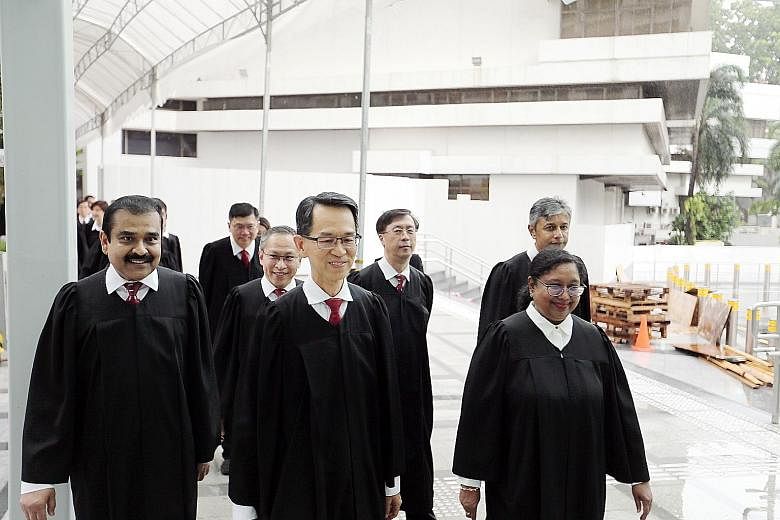It took district judges and staff of the State Courts less than five minutes to march their way into a new era of administering justice at the new State Courts Towers yesterday.
However, it was a move that was more than two decades in the making.
Preliminary plans for a new courthouse started back in the 1990s, after it became evident that the existing infrastructure was insufficient for growing demands, said Presiding Judge of the State Courts, Justice See Kee Oon.
"It was envisioned that our new courthouse would be furnished with a larger physical space, innovative technological capabilities and brand-new amenities," said Justice See, in his address at the old State Courts Building's closing ceremony yesterday.
He then led a procession of district judges and State Courts staff from their old premises to the new State Courts Towers next door, marking the closure of the 44-year-old building in Havelock Square.
The new 35-storey building has harnessed smart technology in various ways, and processes have been improved to help the judiciary adapt and respond to this disruptive age, he added.
For example, the State Courts Towers has a live, instantaneous transcribing system, and there is a separate centre with Internet access, printers and scanners available to all court users.
But the old building, too, was "a modern courthouse of its time", said Justice See, adding that the ingenuity of the building's design could be seen in the layout of the building's functional areas, and the ample space it had to support court users.
But it did present some challenges to users, he reminisced.
"The seemingly maze-like passages caused a fair number of us some confusion and perhaps even mild panic," said Justice See.
"Once, I even guided some foreign visitors down the wrong passageway and made them walk almost a full circle around the building," he said to laughter from the crowd.
Others were also nostalgic about the old building. Tribunal Magistrate Anne Durray said a particularly endearing trait of the old building was its circular structure.
"No matter what, you will definitely find the court you're going to if it's on that floor," said Ms Durray, who first joined the State Courts, then known as the Subordinate Courts, in 2000 as a judicial administrator.
The old octagonal building will now be retrofitted to house the Family Justice Courts, while the new premises will be fully operational from Monday.
Said Justice See: "We hope that we will be able to look back upon today, and see that the State Courts have not merely moved from one building to another, but also entered a new era in being even more effective in administering justice."


